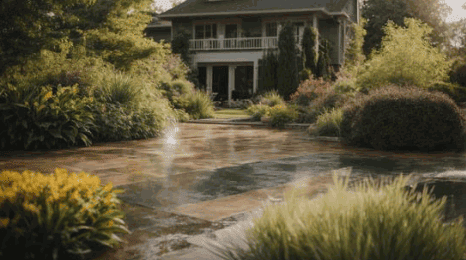
Are you tired of spending hours on manual labour to keep your outdoor space looking presentable? Do you find yourself questioning whether pressure washing is considered a part of landscaping? This article will provide clarity on this common concern and help you understand the importance of incorporating pressure washing into your landscaping routine.
Table of Contents
Pressure washing is a method of cleaning surfaces using a high-pressure water spray. It is commonly used to remove dirt, grime, mold, and loose paint from surfaces such as buildings, vehicles, and concrete surfaces. The force of the water spray can be adjusted depending on the surface being cleaned and the level of cleaning required.
Pressure washing is an effective way to maintain and improve the appearance of various outdoor structures and surfaces.
Delve further: Can You Pressure Wash The Interior Walls
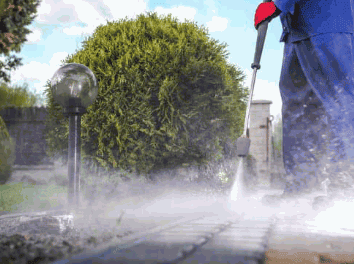
Pressure washing is a popular method for cleaning outdoor surfaces, but is it considered a part of landscaping? In this section, we will discuss the benefits of pressure washing for landscaping and how it can improve the overall appearance and health of your outdoor spaces. From removing built-up dirt and grime to preventing damage to surfaces, pressure washing offers a range of advantages for maintaining a beautiful and well-maintained landscape. Let's take a closer look at each of these benefits and how they contribute to the overall success of your landscaping efforts.
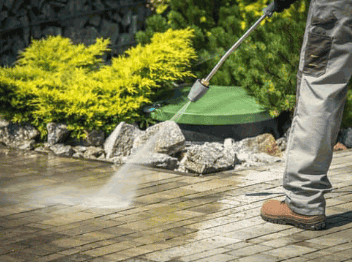
Inspect the surface to identify the extent of dirt and grime accumulation.
Prepare the pressure washing equipment by connecting it to a water source and ensuring proper nozzle attachment.
Apply a suitable detergent or cleaning solution to the surface to help loosen the dirt and grime.
Adjust the pressure washer settings based on the surface material to avoid damage.
Begin pressure washing in a consistent and overlapping pattern to ensure thorough cleaning.
Rinse the surface with clean water to remove the loosened dirt and grime.
Inspect the cleaned area to ensure all dirt and grime have been effectively removed.
Remove dirt and grime from surfaces using high-pressure water. Eliminate mould, mildew, and other unsightly stains to enhance the visual appeal of various surfaces. Revitalise outdoor spaces by cleaning walkways, decks, driveways, and fences.
Regular pressure washing prevents damage to surfaces by removing mold, mildew, and algae, which can degrade and discolour surfaces over time. It helps in preserving the structural integrity of surfaces by preventing the buildup of dirt and grime, which can lead to deterioration. Pressure washing also aids in maintaining the aesthetic appeal of surfaces, preventing the need for costly repairs or replacements.
Pressure washing can be considered a part of landscaping when it involves cleaning and maintaining outdoor surfaces like driveways, decks, and patios. It helps in enhancing the overall aesthetic appeal of the outdoor space by removing dirt, grime, and mildew.
However, landscaping primarily encompasses the modification of the visible features of an area, while pressure washing contributes to the maintenance and upkeep of these features.
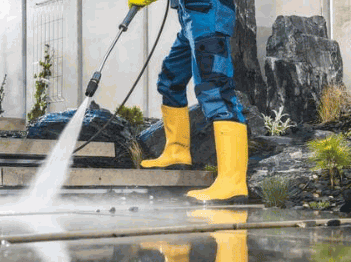
The similarities between pressure washing and landscaping lie in their shared goal of enhancing the appearance and longevity of outdoor spaces. Both focus on preserving or restoring the pristine condition of surfaces, whether it's removing dirt from driveways or revitalising the patios. Additionally, they contribute to overall property maintenance, safeguarding against deterioration and promoting a clean, inviting environment.
Pressure washing and landscaping differ in their primary focus and techniques.
Focus: Pressure washing primarily involves cleaning and restoring surfaces, while landscaping focuses on the design, installation, and maintenance of outdoor spaces.
Techniques: Pressure washing utilizes high-pressure water to clean surfaces, whereas landscaping involves activities like planting, pruning, and hardscaping.
While pressure washing is commonly associated with cleaning exterior surfaces, it has many other practical uses in landscaping. In this section, we will explore how pressure washing can be utilised for tasks beyond just cleaning. From preparing surfaces for painting to cleaning gutters and downspouts, pressure washing can be a valuable tool for maintaining and enhancing your outdoor spaces. Let's take a closer look at the various ways pressure washing can be incorporated into your landscaping routine.
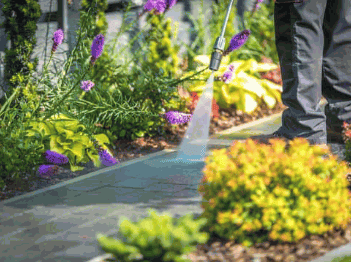
Step 1: Clean the Surface:
Remove any dirt, dust, or debris from the surface using a pressure washer to ensure a smooth and clean area for painting or staining.
Step 2: Repair Any Damage:
Inspect the surface for any cracks, chips, or peeling paint. Repair and patch these areas before painting or staining to ensure a uniform and professional finish.
Step 3: Apply Pre-Treatment:
Use a suitable pre-treatment solution to prepare the surface for painting or staining. This can include primers, sealers, or conditioners to enhance the adhesion and durability of the paint or stain.
Step 4: Allow Surface to Dry:
After pressure washing and pre-treatment, allow the surface to thoroughly dry before applying any paint or stain. Adequate drying time is crucial for the success of the painting or staining process.
Inspect the affected surfaces to identify the extent of weed and moss infestation.
Use appropriate tools such as a pressure washer with a nozzle suitable for delicate surfaces to gently remove the weeds and moss.
Adjust the pressure and angle of the water stream to ensure thorough yet safe removal.
Consider using eco-friendly cleaning solutions to aid in the removal process while being mindful of the surrounding landscaping.
After the cleaning process, apply preventive measures to inhibit the regrowth of weeds and moss.
Inspect the gutters and downspouts for clogs, debris, and any signs of damage.
Inspect the gutters and downspouts again to ensure they are clean and free of any obstructions.